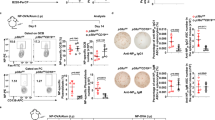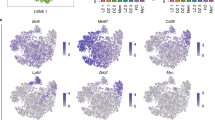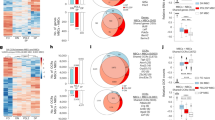Abstract
B cells producing high-affinity antibodies are destined to differentiate into memory B cells and plasma cells, but the mechanisms leading to those differentiation pathways are mostly unknown. Here we report that the transcription factor IRF4 is required for the generation of plasma cells. Transgenic mice with conditional deletion of Irf4 in germinal center B cells lacked post–germinal center plasma cells and were unable to differentiate memory B cells into plasma cells. Plasma cell differentiation required IRF4 as well as the transcriptional repressor Blimp-1, which both acted 'upstream' of the transcription factor XBP-1. In addition, IRF4-deficient B cells had impaired expression of activation-induced deaminase and lacked class-switch recombination, suggesting an independent function for IRF4 in this process. These results identify IRF4 as a crucial transcriptional 'switch' in the generation of functionally competent plasma cells.
This is a preview of subscription content, access via your institution
Access options
Subscribe to this journal
Receive 12 print issues and online access
$209.00 per year
only $17.42 per issue
Buy this article
- Purchase on Springer Link
- Instant access to full article PDF
Prices may be subject to local taxes which are calculated during checkout







Similar content being viewed by others
References
MacLennan, I.C. Germinal centers. Annu. Rev. Immunol. 12, 117–139 (1994).
Rajewsky, K. Clonal selection and learning in the antibody system. Nature 381, 751–758 (1996).
Ye, B.H. et al. The BCL6 proto-oncogene controls germinal-centre formation and Th2-type inflammation. Nat. Genet. 16, 161–170 (1997).
Dent, A.L., Shaffer, A.L., Yu, X., Allman, D. & Staudt, L.M. Control of inflammation, cytokine expression, and germinal center formation by BCL6. Science 276, 589–592 (1997).
Angelin-Duclos, C., Cattoretti, G., Lin, K.I. & Calame, K. Commitment of B lymphocytes to a plasma cell fate is associated with Blimp-1 expression in vivo. J. Immunol. 165, 5462–5471 (2000).
Falini, B. et al. A monoclonal antibody (MUM1p) detects expression of the MUM1/IRF4 protein in a subset of germinal center B cells, plasma cells, and activated T cells. Blood 95, 2084–2092 (2000).
Raaphorst, F.M. et al. Cutting edge: polycomb gene expression patterns reflect distinct B cell differentiation stages in human germinal centers. J. Immunol. 164, 1–4 (2000).
Basso, K. et al. Tracking CD40 signaling during germinal center development. Blood 104, 4088–4096 (2004).
Fornek, J.L. et al. Critical role for STAT3 in T-dependent terminal differentiation of IgG B cells. Blood 107, 1085–1091 (2006).
Scheeren, F.A. et al. STAT5 regulates the self-renewal capacity and differentiation of human memory B cells and controls BCL6 expression. Nat. Immunol. 6, 303–313 (2005).
Shapiro-Shelef, M. et al. Blimp-1 is required for the formation of immunoglobulin secreting plasma cells and pre-plasma memory B cells. Immunity 19, 607–620 (2003).
Eisenbeis, C.F., Singh, H. & Storb, U. Pip, a novel IRF family member, is a lymphoid-specific, PU.1-dependent transcriptional activator. Genes Dev. 9, 1377–1387 (1995).
Matsuyama, T. et al. Molecular cloning of LSIRF, a lymphoid-specific member of the interferon regulatory factor family that binds the interferon-stimulated response element (ISRE). Nucleic Acids Res. 23, 2127–2136 (1995).
Yamagata, T. et al. A novel interferon regulatory factor family transcription factor, ICSAT/Pip/LSIRF, that negatively regulates the activity of interferon-regulated genes. Mol. Cell. Biol. 16, 1283–1294 (1996).
Iida, S. et al. Deregulation of MUM1/IRF4 by chromosomal translocation in multiple myeloma. Nat. Genet. 17, 226–230 (1997).
Mamane, Y. et al. Interferon regulatory factors: the next generation. Gene 237, 1–14 (1999).
Pernis, A.B. The role of IRF4 in B and T cell activation and differentiation. J. Interferon Cytokine Res. 22, 111–120 (2002).
Marecki, S. & Fenton, M.J. The role of IRF4 in transcriptional regulation. J. Interferon Cytokine Res. 22, 121–133 (2002).
van der Stoep, N., Quinten, E., Marcondes Rezende, M. & van den Elsen, P.J. E47, IRF4, and PU.1 synergize to induce B-cell-specific activation of the class II transactivator promoter III (CIITA-PIII). Blood 104, 2849–2857 (2004).
Gupta, S., Jiang, M., Anthony, A. & Pernis, A.B. Lineage-specific modulation of interleukin 4 signaling by interferon regulatory factor 4. J. Exp. Med. 190, 1837–1848 (1999).
Lu, R., Medina, K.L., Lancki, D.W. & Singh, H. IRF4,8 orchestrate the pre-B-to-B transition in lymphocyte development. Genes Dev. 17, 1703–1708 (2003).
Mittrücker, H.W. et al. Requirement for the transcription factor LSIRF/IRF4 for mature B and T lymphocyte function. Science 275, 540–543 (1997).
Rosenwald, A. et al. Molecular diagnosis of primary mediastinal B cell lymphoma identifies a clinically favorable subgroup of diffuse large B cell lymphoma related to Hodgkin lymphoma. J. Exp. Med. 198, 851–862 (2003).
Savage, K.J. et al. The molecular signature of mediastinal large B-cell lymphoma differs from that of other diffuse large B-cell lymphomas and shares features with classical Hodgkin lymphoma. Blood 102, 3871–3879 (2003).
Farley, F.W., Soriano, P., Steffen, L.S. & Dymecki, S.M. Widespread recombinase expression using FLPeR (flipper) mice. Genesis 28, 106–110 (2000).
Casola, S. et al. Tracking germinal center B cells expressing germline immunoglobulin γ1 transcripts by conditional gene targeting. Proc. Natl. Acad. Sci. USA 103, 7396–7401 (2006).
Kraal, G., Weissman, I.L. & Butcher, E.C. Germinal centre B cells: antigen specificity and changes in heavy chain class expression. Nature 298, 377–379 (1982).
Ridderstad, A. & Tarlinton, D.M. Kinetics of establishing the memory B cell population as revealed by CD38 expression. J. Immunol. 160, 4688–4695 (1998).
Sanderson, R.D., Lalor, P. & Bernfield, M. B lymphocytes express and lose syndecan at specific stages of differentiation. Cell Regul. 1, 27–35 (1989).
Blink, E.J. et al. Early appearance of germinal center-derived memory B cells and plasma cells in blood after primary immunization. J. Exp. Med. 201, 545–554 (2005).
Shaffer, A.L. et al. XBP-1, downstream of Blimp-1, expands the secretory apparatus and other organelles, and increases protein synthesis in plasma cell differentiation. Immunity 21, 81–93 (2004).
Reimold, A.M. et al. Plasma cell differentiation requires the transcription factor XBP-1. Nature 412, 300–307 (2001).
Peitz, M., Pfannkuche, K., Rajewsky, K. & Edenhofer, F. Ability of the hydrophobic FGF and basic TAT peptides to promote cellular uptake of recombinant Cre recombinase: a tool for efficient genetic engineering of mammalian genomes. Proc. Natl. Acad. Sci. USA 99, 4489–4494 (2002).
Layton, J.E., Vitetta, E.S., Uhr, J.W. & Krammer, P.H. Clonal analysis of B cells induced to secrete IgG by T cell-derived lymphokine(s). J. Exp. Med. 160, 1850–1863 (1984).
Muramatsu, M. et al. Class switch recombination and hypermutation require activation-induced cytidine deaminase (AID), a potential RNA editing enzyme. Cell 102, 553–563 (2000).
Kinoshita, K., Harigai, M., Fagarasan, S., Muramatsu, M. & Honjo, T. A hallmark of active class switch recombination: transcripts directed by I promoters on looped-out circular DNAs. Proc. Natl. Acad. Sci. USA 98, 12620–12623 (2001).
Hasbold, J., Corcoran, L.M., Tarlinton, D.M., Tangye, S.G. & Hodgkin, P.D. Evidence from the generation of immunoglobulin G–secreting cells that stochastic mechanisms regulate lymphocyte differentiation. Nat. Immunol. 5, 55–63 (2004).
Hasbold, J., Lyons, A.B., Kehry, M.R. & Hodgkin, P.D. Cell division number regulates IgG1 and IgE switching of B cells following stimulation by CD40 ligand and IL-4. Eur. J. Immunol. 28, 1040–1051 (1998).
Randall, T.D. et al. Arrest of B lymphocyte terminal differentiation by CD40 signaling: mechanism for lack of antibody-secreting cells in germinal centers. Immunity 8, 733–742 (1998).
Knödel, M., Kuss, A.W., Berberich, I. & Schimpl, A. Blimp-1 over-expression abrogates IL-4- and CD40-mediated suppression of terminal B cell differentiation but arrests isotype switching. Eur. J. Immunol. 31, 1972–1980 (2001).
Weiss, U. & Rajewsky, K. The repertoire of somatic antibody mutants accumulating in the memory compartment after primary immunization is restricted through affinity maturation and mirrors that expressed in the secondary response. J. Exp. Med. 172, 1681–1689 (1990).
McHeyzer-Williams, M.G., McLean, M.J., Lalor, P.A. & Nossal, G.J. Antigen-driven B cell differentiation in vivo. J. Exp. Med. 178, 295–307 (1993).
Smith, K.G., Light, A., Nossal, G.J. & Tarlinton, D.M. The extent of affinity maturation differs between the memory and antibody-forming cell compartments in the primary immune response. EMBO J. 16, 2996–3006 (1997).
Klein, U. et al. Transcriptional analysis of the B cell germinal center reaction. Proc. Natl. Acad. Sci. USA 100, 2639–2644 (2003).
Lohoff, M. et al. Enhanced TCR-induced apoptosis in interferon regulatory factor 4-deficient CD4+ Th cells. J. Exp. Med. 200, 247–253 (2004).
Kallies, A. et al. Plasma cell ontogeny defined by quantitative changes in Blimp-1 expression. J. Exp. Med. 200, 967–977 (2004).
Sciammas, R. & Davis, M.M. Modular nature of Blimp-1 in the regulation of gene expression during B cell maturation. J. Immunol. 172, 5427–5440 (2004).
Gonda, H. et al. The balance between Pax5 and Id2 activities is the key to AID gene expression. J. Exp. Med. 198, 1427–1437 (2003).
Cattoretti, G. et al. Nuclear and cytoplasmic AID in extrafollicular and germinal center B cells. Blood 107, 3967–3975 (2006).
Lee, C.H. et al. Regulation of the germinal center gene program by interferon (IFN) regulatory factor 8/IFN consensus sequence-binding protein. J. Exp. Med. 203, 63–72 (2006).
Cattoretti, G. et al. PRDM1/Blimp-1 is expressed in human B-lymphocytes committed to the plasma cell lineage. J. Pathol. 206, 76–86 (2005).
Klein, U., Esposito, G., Baudat, F., Keeney, S. & Jasin, M. Mice deficient for the type II topoisomerase-like DNA transesterase Spo11 show normal immunoglobulin somatic hypermutation and class switching. Eur. J. Immunol. 32, 316–321 (2002).
Faili, A. et al. AID-dependent somatic hypermutation occurs as a DNA single-strand event in the BL2 cell line. Nat. Immunol. 3, 815–821 (2002).
Acknowledgements
We thank P. Smith and M. Benito for help with the immunohistochemistry; M. Deren for genotyping; J. Gao for help with ELISA; K. Gordon and S. Stefanova for cell sorting; V. Miljkovic for sequencing; M. Alizhamov for pEasyFlox; D. Tarlinton (Walter Eliza Hall Institute, Parkville, Australia) for advice on the detection of NP-binding B cells; and L. Pasqualucci, M. Saito and A. Pernis for discussions. Supported by the National Institutes of Health (CA92625 and CA098285 to K.R. and CA92625 and CA37295 to R.D.-F.) and the Human Frontiers Science Program (U.K.).
Author information
Authors and Affiliations
Contributions
U.K. designed research, did experiments, analyzed data and wrote the manuscript; R.D.-F. designed research and wrote the manuscript; S.C. and K.R. contributed the Cγ1-Cre mouse, which was critical for this analysis, and designed research; G.C. did the immunostaining experiments and analyzed data; Q.S. did the embryonic stem cell injection and ELISA; M.L. did the VH sequencing analysis; T.M. maintained and genotyped the mouse cohort; and T.L. was involved in construction of the transgenic Irf4 mouse and provided materials.
Note: Supplementary information is available on the Nature Immunology website.
Corresponding author
Ethics declarations
Competing interests
The authors declare no competing financial interests.
Supplementary information
Supplementary Fig. 1
Generation and functional analysis of the conditional Irf4 allele (PDF 109 kb)
Supplementary Fig. 2
Functionality of the conditional Irf4 allele in vivo. (PDF 280 kb)
Supplementary Fig. 3
Absence of plasma cells in Irf4f1/−Cγ1-Cre mice. (PDF 51 kb)
Supplementary Fig. 4
Production of IgG1+ cells in B cell cultures from Irf4fl/−Cγ1-Cre mice stimulated with CD40 plus IL-4 and CSFE analysis of CD40 plus IL-4-stimulated Irf4−/− cells. (PDF 159 kb)
Supplementary Fig. 5
IgG1+eGFP+ B cells in Irf4fl/−Cγ1-Cre mice display a phenotype typical of memory B cells. (PDF 72 kb)
Supplementary Fig. 6
Lack of memory to plasma cell differentiation in Irf4fl/−Cγ1-Cre mice. (PDF 99 kb)
Supplementary Table 1
Sequence analysis of γ1 (membrane-form) transcripts amplified splenic and PB B cells of Irf4fl/−, Irf4fl/+ and Irf4+/− mice at day 14 after NP-KLH immunization. (PDF 23 kb)
Supplementary Table 2
Sequence analysis of γ1 transcripts amplified from B cell purified from Irf4fl/−Cγ1-Cre and Irf4fl/+Cγ1-Cre mice at day 14 after NP-KLH immunization. (PDF 25 kb)
Supplementary Table 3
Sequence analysis of γ1 transcripts amplified from purified PB B cells of Irf4fl/−Cγ1-Cre and Irf4fl/+Cγ1-Cre mice at day 42 after NP-KLH immunization. (PDF 23 kb)
Rights and permissions
About this article
Cite this article
Klein, U., Casola, S., Cattoretti, G. et al. Transcription factor IRF4 controls plasma cell differentiation and class-switch recombination. Nat Immunol 7, 773–782 (2006). https://doi.org/10.1038/ni1357
Received:
Accepted:
Published:
Issue Date:
DOI: https://doi.org/10.1038/ni1357
This article is cited by
-
Genome-wide CRISPR/Cas9 screen identifies regulators of BCMA expression on multiple myeloma cells
Blood Cancer Journal (2024)
-
PRC2 mediated KLF2 down regulation: a therapeutic and diagnostic axis during tumor progression
Cancer Cell International (2023)
-
BRAF(V600E) mutation together with loss of Trp53 or pTEN drives the origination of hairy cell leukemia from B-lymphocytes
Molecular Cancer (2023)
-
The role of transcription factors in shaping regulatory T cell identity
Nature Reviews Immunology (2023)
-
Pulmonary inflammation promoted by type-2 dendritic cells is a feature of human and murine schistosomiasis
Nature Communications (2023)



